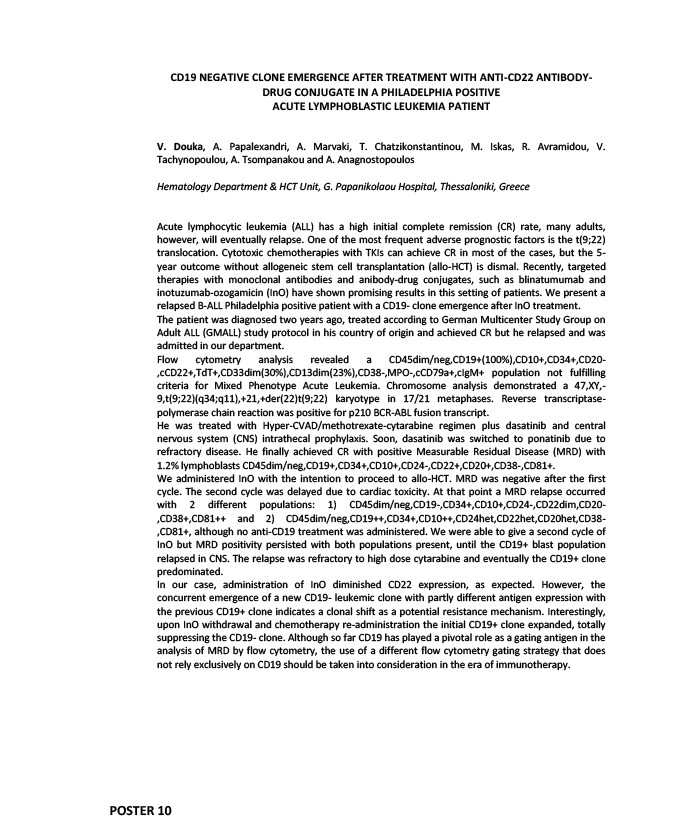
CD19 NEGATIVE CLONE EMERGENCE AFTER TREATMENT WITH ANTI-CD22 ANTIBODY-DRUG
POSTER 10
CONJUGATE IN A PHILADELPHIA POSITIVE
ACUTE LYMPHOBLASTIC LEUKEMIA PATIENT
V. Douka, A. Papalexandri, A. Marvaki, T. Chatzikonstantinou, M. Iskas, R. Avramidou, V.
Tachynopoulou, A. Tsompanakou and A. Anagnostopoulos
Hematology Department & HCT Unit, G. Papanikolaou Hospital, Thessaloniki, Greece
Acute lymphocytic leukemia (ALL) has a high initial complete remission (CR) rate, many adults,
however, will eventually relapse. One of the most frequent adverse prognostic factors is the t(9;22)
translocation. Cytotoxic chemotherapies with TKIs can achieve CR in most of the cases, but the 5-
year outcome without allogeneic stem cell transplantation (allo-HCT) is dismal. Recently, targeted
therapies with monoclonal antibodies and anibody-drug conjugates, such as blinatumumab and
inotuzumab-ozogamicin (InO) have shown promising results in this setting of patients. We present a
relapsed B-ALL Philadelphia positive patient with a CD19- clone emergence after InO treatment.
The patient was diagnosed two years ago, treated according to German Multicenter Study Group on
Adult ALL (GMALL) study protocol in his country of origin and achieved CR but he relapsed and was
admitted in our department.
Flow cytometry analysis revealed a CD45dim/neg,CD19+(100%),CD10+,CD34+,CD20-
,cCD22+,TdT+,CD33dim(30%),CD13dim(23%),CD38-,MPO-,cCD79a+,cIgM+ population not fulfilling
criteria for Mixed Phenotype Acute Leukemia. Chromosome analysis demonstrated a 47,XY,-
9,t(9;22)(q34;q11),+21,+der(22)t(9;22) karyotype in 17/21 metaphases. Reverse transcriptase-polymerase
chain reaction was positive for p210 BCR-ABL fusion transcript.
He was treated with Hyper-CVAD/methotrexate-cytarabine regimen plus dasatinib and central
nervous system (CNS) intrathecal prophylaxis. Soon, dasatinib was switched to ponatinib due to
refractory disease. He finally achieved CR with positive Measurable Residual Disease (MRD) with
1.2% lymphoblasts CD45dim/neg,CD19+,CD34+,CD10+,CD24-,CD22+,CD20+,CD38-,CD81+.
We administered InO with the intention to proceed to allo-HCT. MRD was negative after the first
cycle. The second cycle was delayed due to cardiac toxicity. At that point a MRD relapse occurred
with 2 different populations: 1) CD45dim/neg,CD19-,CD34+,CD10+,CD24-,CD22dim,CD20-
,CD38+,CD81++ and 2) CD45dim/neg,CD19++,CD34+,CD10++,CD24het,CD22het,CD20het,CD38-
,CD81+, although no anti-CD19 treatment was administered. We were able to give a second cycle of
InO but MRD positivity persisted with both populations present, until the CD19+ blast population
relapsed in CNS. The relapse was refractory to high dose cytarabine and eventually the CD19+ clone
predominated.
In our case, administration of InO diminished CD22 expression, as expected. However, the
concurrent emergence of a new CD19- leukemic clone with partly different antigen expression with
the previous CD19+ clone indicates a clonal shift as a potential resistance mechanism. Interestingly,
upon InO withdrawal and chemotherapy re-administration the initial CD19+ clone expanded, totally
suppressing the CD19- clone. Although so far CD19 has played a pivotal role as a gating antigen in the
analysis of MRD by flow cytometry, the use of a different flow cytometry gating strategy that does
not rely exclusively on CD19 should be taken into consideration in the era of immunotherapy.